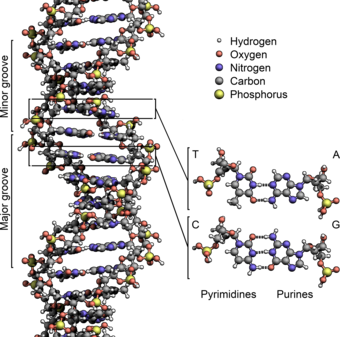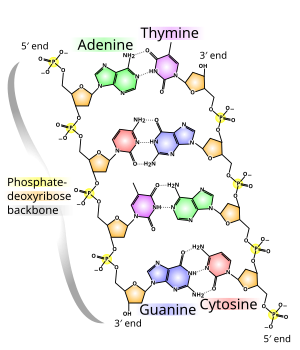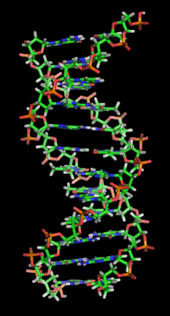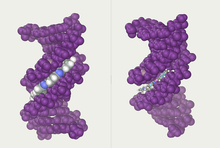Register for free to join our community of investors and share your ideas. You will also get access to streaming quotes, interactive charts, trades, portfolio, live options flow and more tools.
why does this stock still trade?
yeh BUD, Unfortunately.
He Sold DNAPrint (under the name AncestrybyDNA), to the DNA Diagnostics Center.
But hey, DNAG was an adventure – it was exciting – it was a first step – and we learned a lot. ![]()
22 years years later and Tony still has not taken this one to the big boards. Busted dreams for a few, but I am sure he made a dollar or two. That is what is important right?
still holding. I like the name:))
They were the first company to introduce forensic and consumer genomics products, which were developed immediately upon the publication of the first complete draft of the human genome in the early 2000s
DNA Diagnostics Center acquired the rights to the AncestrybyDNA name, testing procedures, and report generation from DNAPrint in 2009
https://isogg.org/wiki/DNAPrint_Genomics
Volume today ????
This is very interesting...wouldn't you all agree?
https://na01.safelinks.protection.outlook.com/?url=https%3A%2F%2Fwww.latimes.com%2Fbusiness%2Fstory%2F2021-04-13%2Fcolumn-blackstone-ancestry-genetic-privacy&data=04%7C01%7C%7C9a1a5e52291b41c03d0308d8ff7e7283%7C84df9e7fe9f640afb435aaaaaaaaaaaa%7C1%7C0%7C637540265834689107%7CUnknown%7CTWFpbGZsb3d8eyJWIjoiMC4wLjAwMDAiLCJQIjoiV2luMzIiLCJBTiI6Ik1haWwiLCJXVCI6Mn0%3D%7C1000&sdata=S6wMO8QplNlj0qc3vdmSu%2BircXsTqBD%2FU1odkYga%2F90%3D&reserved=0
I don't think there is anyone working for the company, let alone 24..
BUT, someone somewhere thinks a patent owned by this defunct shell of a going concern has value and is willing to pay up for it..
Here's hoping we get a reasonable price for whatever intellectual property is there......GLTA....
It's been a steady raise. I'm comfortable. They still have 24 employees.
... Pulled from ResearchGate
Authors:
Tony Frudakis
M. Thomas
Z. Gaskin
Hector J Gomez
GLG Pharma
Mr. Zach Gaskin Exec. Officer, has been there since the beginning of
company.
Listed Executives for DNAG on Yahoo which is new?
Does anyone here recognize any of the names?
Name Title Pay Exercised Year Born
Mr. Jatin Patel Exec. Officer N/A N/A N/A
Dr. Laurence A. Rubin M.D., FRCPC FACP Exec. Officer N/A N/A N/A
Mr. Naz Jiwani BBA, CIRM Exec. Officer N/A N/A N/A
Ms. Pauline Gula Exec. Officer N/A N/A N/A
Mr. Zach Gaskin Exec. Officer N/A N/A N/A
Ms. Emanuela Charlton Exec. Officer N/A N/A N/A
Ms. Lisa Tandy Herren Exec. Officer N/A N/A N/A
Mr. Scot Alic Exec. Officer N/A N/A N/A
Mr. Shannon Boyd Exec. Officer N/A N/A N/A
Dr. Hector de Jesus Ruiz Exec. Officer N/A N/A 1946
Maybe this is why?...The spit-in-tube DNA you send in is anonymized and used for genetic drug research and both sites have been selling the data to third-party companies, like P&G Beauty and Pepto-Bismol, and universities, like The University of Chicago, for some time. In fact, just last week major pharmaceutical giant, GlaxoSmithKline, announced a $300 million deal with XXXXX
I have held my shares for a very long time too... At least they have 24 employees at this moment:
https://finance.yahoo.com/quote/DNAG/profile?p=DNAG
i have held on to DNAG for a l-o-n-g time ....what is very odd
to me, is that 90,000,000 shares have traded since New Years !!!
Who is buying this stock with a phone on a desk somewhere and
no one there to answer it???? What does DNA Print have that anyone wants???? Inquiring minds would like to know...GLTA...
Yep very interesting : up 75 % , based on what?
i find it odd that there website is back up.....
Yes, you may ask.
I'm an HR nerd so I use various tools and track hiring, and for what type of new jobs are posted.
Example: I discovered BNGO at .37 and grabbed shares...they closed at 12.58 today. Works for me!
may i ask where you find those numbers at?
They now have 24 employees. I smell something cooking.
E*trade will not let you buy a Caveat Emptor.
Ameritrade will not let you buy a Caveat Emptor, after January 30, 2021. https://www.reddit.com/r/pennystocks/comments/kfv97i/ameritrade_to_restrict_otc_trading/
T/A verified security details on 01/07/2021 https://www.otcmarkets.com/stock/DNAG/security
Hello,
Watch what's happening now: 10 M trade ?! My portfolio up 12 K. Love it!
Hello,
Any idea why 2 million shares traded today?
I had a similar stock do this sevral years and the vslue went fro sub pennys to 8 o dollars per share so im holding on to my practically worthless shares oasyou dont know what the future brings DNAG is a great ticker to use for snother business also You dont know what the intellectual value of the data they hold id worth.
Can anyone tell me if DNAG can be used as a tax write off? This is an article I found from Bankrate that supports the idea of a write off to offset capital gains? Thanks in advance.
insert-text-here
But what if your shares of a corporation dropped off the stock market radar before you were able to unload them? You might be able to write off the holding on your tax return as a worthless stock.
?Just because a company is in bankruptcy, or its stock isn’t trading, doesn’t necessarily mean it’s worthless. If it’s worth even a few pennies, it still has value in the eyes of the IRS.
If you truly do have a dead stock in your portfolio, you treat it on your tax return as if it were a capital asset you sold for zero dollars on the last day of the tax year.
Documentation for the IRS
When you report a worthless-stock transaction, you don’t have to put the details of the stock’s demise on your return.
However, tax experts say if you’re questioned by the IRS, you need to be prepared to show:
There is no hope investors will ever get anything for their holdings. This isn’t always easy, so do your homework.
When the security became worthless. You must reasonably determine the date the stock lost all its value.
Once you’re armed with that information, it’s time to report your loss.
I have read that there are groups of people that petition the courts that hold jurisdiction in the stock's registration state to find the stock abandoned by the owner(s) and then buy the symbol to repurpose and resale the shell.
Did you notice that after not trading for a long time we go past .0001 and are trading at .0002 yesterday.. Something going on here. Still holding my position here..
It was that for sure.
Price
$0.0002
Day's Change 0.0002 (952.63%)
I have 60000 shares of this stock evidently they kept the ticker out there. I had a stock do something like this one and it changed the company but purchased the ticker and it went to 9.00 per share. Didn't have 60000 shares of course lol. What a bloodbath.
Me too. I had just opened up an account to trade stocks in January 2000. I read that DNAPRINT was reverse merging, with Catalyst Communications. I got in late, but the reward would have been 3.5 times my investment. My first big buy and I watched it dwindle away in August of 2000. Learned valuable lessons on DNAP. I have another play going which is a reverse merger. Only this time the company going public via the r/m is making good money as opposed to Catalyst that was not doing much, of anything back then. This time I will sell and not worry, about what some CEO says to sell me a bill of goods that may or may not come true. The stock symbol is LAHO. I also learned not to invest over the top and expect a major payout. Got to keep some money to play another day.
You're correct orangecat, I was invested in DNAG when they went under many years ago. If prospective "investors" go to their wiki page, look for the keyword "was" in the description of the company.
https://en.wikipedia.org/wiki/DNAPrint_Genomics
This company went out of business over 9 years ago.
Volume today again...
DNA Diagnostics Center acquired the rights to the AncestrybyDNA name, testing procedures, and report generation from DNAPrint in 2009
https://isogg.org/wiki/DNAPrint_Genomics
Volume today ????
The kicker is his technology has just been expanded on now they are saying a company is giving police a photo of the suspect from the DNA. Can't predict age. They've used it so far and caught 2 people. That's unbelievable. I forget the company. And there's still a back log of untested rape evidence kits sitting in police station storage rooms across the country. Mr. Frudakis at the time knew they had 1000's of kits across the country he could ran those DNA tests and put them in a data base.
The Gore Bush election debacle saw Dnap/Dnag really taking a hit downward. The last gasp was around 25 cents a share in 2000.
Yeah I lost a ton that day I was up 17k and didn't sell. So Stupid I had friends who were up 110k and didn't sell. UGH so very stupid. I was here then too.
Dr. Frudakis's new gig: http://daindunston.com/innovation-in-desalination-okeanos-technologies/
DNAP..A long long time ago..
Sold my shares long ago and moved on. Memories of August 2000 are still fresh in my mind. It was fun watching DNAP reach the 30 cent area for a while that one day in August. Good to see you are still around too.
Happy trails to you as well.
Hal
|
Followers
|
297
|
Posters
|
|
|
Posts (Today)
|
0
|
Posts (Total)
|
82595
|
|
Created
|
08/19/00
|
Type
|
Free
|
| Moderators | |||
DNA


Deoxyribonucleic acid (DNA) is a molecule encoding the genetic instructions used in the development and functioning of all known living organisms and many viruses. Along with RNA and proteins, DNA is one of the three major macromolecules that are essential for all known forms of life. Genetic information is encoded as a sequence of nucleotides (guanine, adenine, thymine, and cytosine) recorded using the letters G, A, T, and C. Most DNA molecules are double-stranded helices, consisting of two long polymers of simple units called nucleotides, molecules with backbones made of alternating sugars (deoxyribose) and phosphate groups (related to phosphoric acid), with the nucleobases (G, A, T, C) attached to the sugars. DNA is well-suited for biological information storage, since the DNA backbone is resistant to cleavage and the double-stranded structure provides the molecule with a built-in duplicate of the encoded information.
These two strands run in opposite directions to each other and are therefore anti-parallel, one backbone being 3' (three prime) and the other 5' (five prime). This refers to the direction the 3rd and 5th carbon on the sugar molecule is facing. Attached to each sugar is one of four types of molecules called nucleobases (informally, bases). It is the sequence of these four nucleobases along the backbone that encodes information. This information is read using the genetic code, which specifies the sequence of the amino acids within proteins. The code is read by copying stretches of DNA into the related nucleic acid RNA in a process called transcription.
Within cells, DNA is organized into long structures called chromosomes. During cell division these chromosomes are duplicated in the process of DNA replication, providing each cell its own complete set of chromosomes. Eukaryotic organisms (animals, plants, fungi, and protists) store most of their DNA inside the cell nucleus and some of their DNA in organelles, such as mitochondria or chloroplasts.[1] In contrast, prokaryotes (bacteria and archaea) store their DNA only in the cytoplasm. Within the chromosomes, chromatin proteins such as histones compact and organize DNA. These compact structures guide the interactions between DNA and other proteins, helping control which parts of the DNA are transcribed.
Properties
DNA is a long polymer made from repeating units called nucleotides.[2][3][4] DNA was first identified and isolated by Friedrich Miescher and the double helix structure of DNA was first discovered by James D. Watson and Francis Crick. The structure of DNA of all species comprises two helical chains each coiled round the same axis, and each with a pitch of 34 ångströms (3.4 nanometres) and a radius of 10 ångströms (1.0 nanometres).[5] According to another study, when measured in a particular solution, the DNA chain measured 22 to 26 ångströms wide (2.2 to 2.6 nanometres), and one nucleotide unit measured 3.3 Å (0.33 nm) long.[6] Although each individual repeating unit is very small, DNA polymers can be very large molecules containing millions of nucleotides. For instance, the largest human chromosome, chromosome number 1, is approximately 220 million base pairs long.[7]
In living organisms DNA does not usually exist as a single molecule, but instead as a pair of molecules that are held tightly together.[8][9] These two long strands entwine like vines, in the shape of a double helix. The nucleotide repeats contain both the segment of the backbone of the molecule, which holds the chain together, and a nucleobase, which interacts with the other DNA strand in the helix. A nucleobase linked to a sugar is called a nucleoside and a base linked to a sugar and one or more phosphate groups is called a nucleotide. A polymer comprising multiple linked nucleotides (as in DNA) is called a polynucleotide.[10]
The backbone of the DNA strand is made from alternating phosphate and sugar residues.[11] The sugar in DNA is 2-deoxyribose, which is a pentose (five-carbon) sugar. The sugars are joined together by phosphate groups that form phosphodiester bonds between the third and fifth carbon atoms of adjacent sugar rings. These asymmetric bonds mean a strand of DNA has a direction. In a double helix the direction of the nucleotides in one strand is opposite to their direction in the other strand: the strands are antiparallel. The asymmetric ends of DNA strands are called the 5′ (five prime) and 3′ (three prime) ends, with the 5' end having a terminal phosphate group and the 3' end a terminal hydroxyl group. One major difference between DNA and RNA is the sugar, with the 2-deoxyribose in DNA being replaced by the alternative pentose sugar ribose in RNA.[9]

The DNA double helix is stabilized primarily by two forces: hydrogen bonds between nucleotides and base-stacking interactions among aromatic nucleobases.[13] In the aqueous environment of the cell, the conjugated π bonds of nucleotide bases align perpendicular to the axis of the DNA molecule, minimizing their interaction with the solvation shell and therefore, the Gibbs free energy. The four bases found in DNA are adenine (abbreviated A), cytosine (C), guanine (G) and thymine (T). These four bases are attached to the sugar/phosphate to form the complete nucleotide, as shown for adenosine monophosphate.
The nucleobases are classified into two types: the purines, A and G, being fused five- and six-membered heterocyclic compounds, and the pyrimidines, the six-membered rings C and T.[9] A fifth pyrimidine nucleobase, uracil (U), usually takes the place of thymine in RNA and differs from thymine by lacking a methyl group on its ring. In addition to RNA and DNA a large number of artificial nucleic acid analogues have also been created to study the properties of nucleic acids, or for use in biotechnology.[14]
Uracil is not usually found in DNA, occurring only as a breakdown product of cytosine. However in a number of bacteriophages - Bacillus subtilis bacteriophages PBS1 and PBS2 and Yersinia bacteriophage piR1-37 - thymine has been replaced by uracil.[15] A modified form (beta-d-glucopyranosyloxymethyluracil) is also found in a number of organisms: the flagellates Diplonema and Euglena, and all the kinetoplastid genera[16] Biosynthesis of J occurs in two steps: in the first step a specific thymidine in DNA is converted into hydroxymethyldeoxyuridine; in the second HOMedU is glycosylated to form J.[17] Proteins that bind specifically to this base have been identified.[18][19][20] These proteins appear to be distant relatives of the Tet1 oncogene that is involved in the pathogenesis of acute myeloid leukemia.[21] J appears to act as a termination signal for RNA polymerase II.[22][23]

| Volume | |
| Day Range: | |
| Bid Price | |
| Ask Price | |
| Last Trade Time: |
